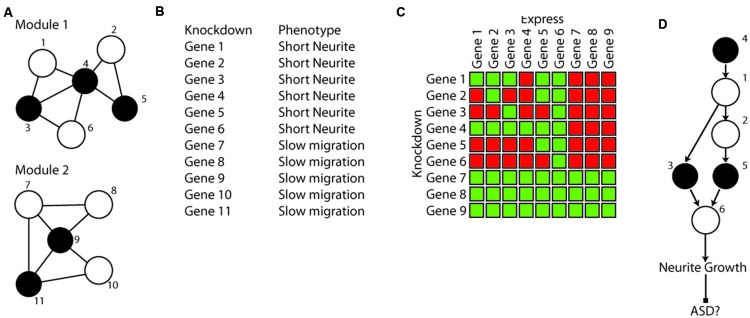FIGURE 3.

Hypothetical example of phenotypical clustering and epistasis analysis in a culture model. (A) A hypothetical network constructed with five ASD genes (black) has resulted in two modules of 5–6 genes that are connected by expression and PPI data that include both ASD genes and tightly connected genes (white) not yet implicated in ASD. (B) The network result leads to a hypothesis that genes that are in the same module regulate the same phenotype. This is tested using single gene knockdown in iPSC derived neurons followed by high content imaging of neuronal morphology and behavior. Knockdown of the members of the two modules results in distinct cellular phenotypes, consistent with them potentially representing two distinct mechanisms of developing ASD (potentially two subtypes requiring different treatments). In this hypothetical example the tightly connected genes show the same phenotype. (C) Epistasis analysis for neurite length is used to test the hypothesis that all genes in module 1 are in the same pathway regulating neurite growth and are distinct from genes in module 2. Single gene knockdowns of all genes are transiently transfected with constructs expressing each individual gene. Green squares are normal neurite length, red squares are shortened neurites. These hypothetical results suggest several conclusions: (1) negative control genes from module 2 can’t rescue short neurites, again indicating they are not in this genetic pathway. (2) As a control, expression of each gene in module 1 can rescue (complement) its own phenotype. (3) The pattern of complementation can be used to infer the functional relationship between the genes (D). For example, gene 4 can be rescued by any other gene in the module, suggesting it must be before the others in the pathway, while gene 6 can rescue all others, but cannot be rescued by any of them, indicating it must be last. (D) The resulting pathway from the genetic analysis of neurite length. This result indicates that the original module did indeed represent a set of genes that regulate the same neurobiological phenomena. If indeed the shortened neurites lead to ASD, this also suggests that treatments targeting gene 6 (even though it was not itself an ASD gene), may be effective at treating individuals with ASD who have mutations in genes 3, 4, or 5.
